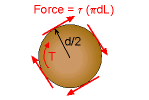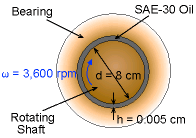| Ch 8. Incompressible and Viscous Flow | Multimedia Engineering Fluids | ||||||
|
Flow between Parallel Plates |
Couette Flow |
Viscous Flow in Pipe |
|||||
| Couette Flow | Case Intro | Theory | Case Solution |
| Chapter |
| 1. Basics |
| 2. Fluid Statics |
| 3. Kinematics |
| 4. Laws (Integral) |
| 5. Laws (Diff.) |
| 6. Modeling/Similitude |
| 7. Inviscid |
| 8. Viscous |
| 9. External Flow |
| 10. Open-Channel |
| Appendix |
| Basic Math |
| Units |
| Basic Fluid Eqs |
| Water/Air Tables |
| Sections |
| eBooks |
| Dynamics |
| Fluids |
| Math |
| Mechanics |
| Statics |
| Thermodynamics |
| ©Kurt Gramoll |
| |
||
|
|
By assuming that the clearance between the rotating shaft and bearing is small and concentric, this problem can then be adequately modeled using flow between parallel plates where the top plate moves at a velocity U and bottom plate is fixed. The velocity profile of the lubricant is given by By assuming that there is no pressure gradient in the x-direction, the velocity becomes u = Uy/h The shear stress exerted on the rotating shaft is τ = μ(du/dy) = μU/h = μ ω d/2h |
|
 Torque |
The torque is given by multiplying the force by its moment arm. That is, T = (τ) (πdL) (d/2) = π μ ω Ld3/4h For SAE-30 oil, the required torque to rotate the shaft is calculated to be: Note: Students are encouraged to calculate the Reynolds number and determine if the assumption of laminar flow is valid. |
|
Practice Homework and Test problems now available in the 'Eng Fluids' mobile app
Includes over 250 free problems with complete detailed solutions.
Available at the Google Play Store and Apple App Store.


